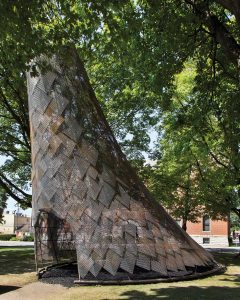Columbus, IN, located about 45 minutes south of Indianapolis, is home to a surprising amount of pioneering architecture given its modest population of 50,000. The city has added so much to the industry that the American Institute of Architects has named it sixth in the country for contributing to architectural innovation and design. The Exhibit Columbus festival celebrates the city’s design heritage each year by presenting current art and architecture. Wiikiaami, presented at the 2017 exhibit, is a steel art structure with an asymmetric, conical shape inspired by the homes of the Myaamia people indigenous to Indiana. Wiikiaami translates to “wigwam” in the native language and is a modern take on the dwellings that were once present in Indiana. The structure tapers from a 37- by 22-foot ellipse at the base to a 6- by 4-foot ellipse at the top. One face of the cone is nearly vertical while the other face gradually slopes up over the 30-foot structure height – from 25° to nearly vertical.
For Wiikiaami’s skin, the architect/artist chose perforated steel scales reminiscent of traditional textiles that wrapped wigwams. A discreet structural frame was desired to promote visibility through the light-pervious scales and achieve the architect’s vision. After considering several options to accommodate the unique geometry and limited budget, A706 weldable reinforcement was chosen to comprise the intricate frame as it was much less expensive than curved HSS sections, and most bar sizes could be bent on-site to the required shape.

Pierce Engineers, Inc., was an Award Winner for its Wiikiaami project in the 2018 Annual Excellence in Structural Engineering Awards Program in the Category – Other Structures. Courtesy of Hadley Fruits.
The shape’s curvature and steep slopes made geometry-dependent loads, such as wind, snow drifts, and ice, particularly challenging. Making assumptions to simplify or generalize loads over the full height resulted in a rebar frame too dense for the architect’s vision and bar diameters too large to bend in-field. Therefore, the structure was discretized over its height and loads were calculated for each section individually. Ice loads were significant due to the unusually high surface area-to-volume ratio of the skin and rebar frame, and governing gravity loads came from the accumulation of snow and ice.
Lateral translation under gravity loads was significant due to lack of plumbness and further compounded high P-Δ effects and wind displacements. Frame-action from vertical members (termed “spines”) and horizontal members (termed “ribs”) alone did not provide enough lateral stiffness. Considering the perforated scales as sheathing to transfer in-plane shear was ineffective as they were curved (thus too flexible) and required too much costly field welding. Diagonal members (termed “struts”) spiraling up the sloping face were added to brace the structure.
Added stiffness from the struts, though required, introduced additional complications. Struts presented a more direct load path as they were inherently much stiffer than spines, but strut size was unreasonable in initial layouts since they could not be bent in-field. The final layout was optimized by positioning struts to have less direct load paths to foundation elements so that the load was shared with spines. A 3-D model of the full structure accounted for curved members, P-δ/Δ effects, and increased flexural stiffness from continuous members and welded connections. Maximum vector deflection from vertical loads was 1 inch and occurred 20 feet up the sloped face. However, lateral displacement contributed to over 60% of this deflection, which is an artifact of Wiikiaami’s out-of-plumb shape.
Rib sizes ranged from #8 bars at the base to #4 bars at the top and were located every 2 feet along the structure height. A total of 20 spines, mostly consisting of #7 and #8 bars with some of the straighter spines being #9s, ran full height and were stiffened by 14 struts. Struts on the sloped face were mostly #8s, while the vertical face required much more curvature and could only be accommodated by #6 and #7 bars. The limitation of being able to field-bend bars was especially challenging for members near the base subjected to nearly 4,000 pounds of compression, a considerable force for slender, unbraced rebar up to 4 feet long. The force required to bend the larger bars with small radii of curvature was studied and quantified, ensuring specified bar sizes were constructible.
Nodal connections between spines, struts, and ribs needed to be quickly assembled and cost-effective, but also rigid enough for adequate stability. Effective buckling lengths for bars in compression were decreased by accounting for fixity at member ends so rotational stiffness at nodes was necessary. This was especially critical as the mid-point of many curved members were out-of-plane and experienced P-δ moments from the onset of loading. Though bolted options were considered, welded connections were ultimately specified due to their stiffness and ability to transfer moments between intersecting members. Welded connections also engaged bars instantly without any bolt slip or “lag,” essential for stability considering the number of connections present. Thus, rebar at connections was welded with 5⁄16-inch U-groove welds on each side of the bar. Similarly, rebar was lapped 12 inches at splices and welded on each side.
To accurately fabricate the complex geometry, plywood platforms were CNC cut to the correct elliptic dimensions and erected with scaffolding. Spines and ribs were then welded along this precise skeleton. Rebar landed on a 4XS pipe section, factory curved to the elliptic shape and supported by helical anchors. Wiikiaami’s conical shape generated substantial thrust forces at the base, despite its small, lightweight frame. Eight 2 3⁄8-inch-diameter helical anchors provided adequate lateral and uplift capacities. Specific anchors were purposely located away from struts and spines to force load distribution in the base pipe to adjacent, lighter loaded anchors.
Wiikiaami was very well received at Exhibit Columbus and was a 2017 Miller Prize recipient. Though it was anticipated to be a temporary structure, it is one of 4 installations from the exhibit remaining in place while a new, permanent location is sought.■
